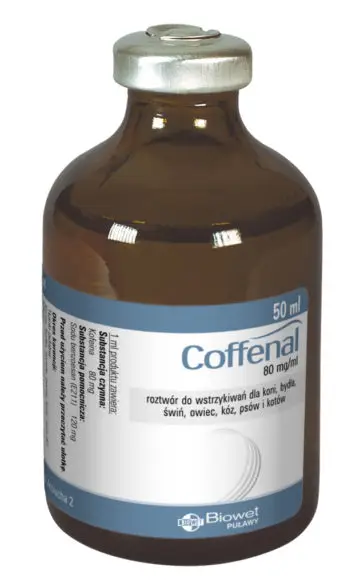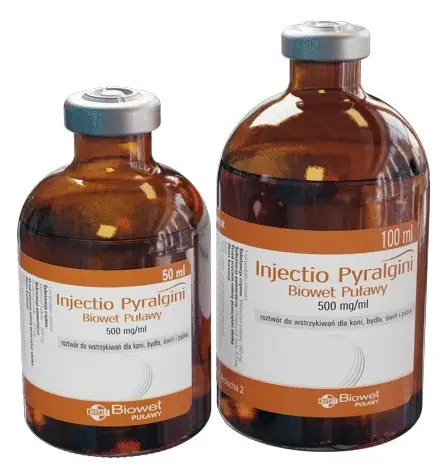Description
Enflocyna 50 mg/ml, solution for injection for cattle, sheep, goats, pigs, cats and dogs
Statement of the active substance(s) and other ingredient(s)
Each ml contains:
Active substance:
Enrofloxacin – 50 mg
Excipient:
Benzyl alcohol E1519 – 15.7 mg
Clear, slightly yellow solution.
Target species
Cattle (calves), sheep, goats, pigs, cats, dogs
Indications for use
Cattle (calves)
Treatment of respiratory infections caused by Pasteurella multocida, Mannheimia haemolytica and Mycoplasma spp. susceptible to enrofloxacin.
Treatment of gastrointestinal infections caused by Escherichia coli susceptible to enrofloxacin.
Treatment of septicaemia caused by Escherichia coli susceptible to enrofloxacin.
Treatment of acute mycoplasma arthritis caused by Mycoplasma bovis susceptible to enrofloxacin.
Sheep
Treatment of gastrointestinal infections caused by Escherichia coli susceptible to enrofloxacin.
Treatment of septicaemia caused by Escherichia coli susceptible to enrofloxacin.
Treatment of mastitis caused by Staphylococcus aureus and Escherichia coli susceptible to enrofloxacin.
Goats
Treatment of respiratory infections caused by Pasteurella multocida, Mannheimia haemolytica susceptible to enrofloxacin.
Treatment of gastrointestinal infections caused by Escherichia coli susceptible to enrofloxacin.
Treatment of septicaemia caused by Escherichia coli susceptible to enrofloxacin.
Treatment of mastitis caused by Staphylococcus aureus and Escherichia coli susceptible to enrofloxacin
Pigs
Treatment of respiratory infections caused by Pasteurella multocida, Mycoplasma spp., Actinobacillus pleuropneumoniae susceptible to enrofloxacin.
Treatment of gastrointestinal infections caused by Escherichia coli susceptible to enrofloxacin.
Treatment of septicaemia caused by Escherichia coli susceptible to enrofloxacin.
Dogs
Treatment of gastrointestinal, respiratory and genitourinary infections (including prostatitis, and as antibiotic therapy supporting treatment of metritis), skin and wound infections, otitis (media/externa) caused by Staphylococcus spp., Escherichiacoli, Pasteurella spp., Klebsiella spp., Bordetella spp., Pseudomonas spp. and Proteus spp. susceptible to enrofloxacin.
Cats
Treatment of gastrointestinal, respiratory and genitourinary infections (including prostatitis, and as antibiotic therapy supporting treatment of metritis), skin and wound infections caused by Staphylococcus spp., Escherichiacoli, Pasteurella spp., Klebsiella spp., Bordetella spp., Pseudomonas spp. and Proteus spp. susceptible to enrofloxacin.
Contraindications
Do not use in case of hypersensitivity to enrofloxacin, other fluoroquinolones or to any excipient.
Do not use in animals with epilepsy or seizure episodes, as enrofloxacin can stimulate the central nervous system.
Do not use in growing dogs, that is: less than 8 months of age in small breed dogs, less than 12 months of age in large breed dogs, less than 18 months of age in giant dog breeds, due to the risk of negative impact on joint cartilage development.
Do not use in cats less than 8 weeks of age due to the risk of negative impact on joint cartilage development and retinal degeneration.
Do not use in young horses due to the risk of negative impact on joint cartilage development.
Special warnings
Special precautions for safe use in the target species:
Fluoroquinolones should be used in treating only those diseases in which observed response to administration of other classes of antimicrobial drugs is not satisfactory or the response to treatment is expected to be insufficient.
The product may only be used in treating infections caused by microbes the sensitivity of which was confirmed by results of antimicrobial resistance testing, and in case of resistance to other chemotherapeutics.
Do not use the product to treat less acute infections.
During product use, comply with the applicable national and local guidelines for using antimicrobial drugs.
Using the product contrary to provisions of the Summary of Product Characteristics may lead to increased frequency of microbial resistance to fluoroquinolones and decreased efficacy of treatment using other quinolones due to emergence of a potential cross-resistance.
Caution is advised when using enrofloxacin in animals with renal failure.
Caution is advised when using enrofloxacin in cats, as doses exceeding the recommended doses may cause retinal degeneration and blindness. In cats below 5 kg body weight, use a dose of 25 mg/ml to avoid overdose.
Degenerative changes in joint cartilage were observed in calves treated with 30 mg of enrofloxacin per kg of body weight, administered per os for 14 days.
Use of enrofloxacin in lambs in the recommended dose for 15 days produced histological changes in joint cartilage, not linked to clinical signs.
Special precautions to be taken by the person administering the veterinary medicinal product to animals:
People with known hypersensitivity to fluoroquinolones should avoid contact with the veterinary medicinal product.
Pregnant women should avoid contacting the veterinary medicinal product directly.
Avoid contact with skin and eyes. In case of accidental contact with skin or eyes, immediately flush the affected area with clean water.
Wash hands after use.
Do not smoke, eat or drink during preparation and administration of the product.
In case of accidental self-injection, seek medical advice immediately and show the package leaflet or the label to the physician.
Pregnancy and lactation:
Laboratory studies in rats and rabbits have not produced any evidence of teratogenic effect, however they have revealed foetotoxic effect in case of administration of doses inducing maternal toxicity.
The safety of the veterinary medicinal product has not been established during pregnancy and lactation.
Use only according to the benefit/risk assessment by the responsible veterinarian.
Interaction with other medicinal products and other forms of interaction:
Do not use enrofloxacin simultaneously with antimicrobials acting as quinolone antagonists (e.g. macrolides, tetracyclines or phenicols).
Do not use the product simultaneously with theophylline, as this may lead to increased theophylline concentrations and delay its elimination.
Caution is advised when administering enrofloxacin simultaneously with flunixin in dogs, in order to avoid adverse effects. Reduction in drug clearance as a result of simultaneous administration of flunixin and enrofloxacin indicates that these substances interact during the phase of drug elimination.
That is why simultaneous administration of enrofloxacin and flunixin in dogs leads to increase in AUC and half-life of the drug at the stage of flunixin elimination, and to increase in half-life at the stage of elimination and reduced Cmax of enrofloxacin.
Overdose:
In case of accidental overdose, gastrointestinal (vomiting, diarrhoea) and nervous system disorders may occur.
No adverse effects have been observed in pigs administered five times the recommended dose.
Cats receiving a dose below 15 mg per kg body weight a day for 21 consecutive days were observed to develop vision disorders. A dose of 30 mg/kg body weight administered once daily for 21 consecutive days led to irreversible damage to sight. A dose of 50 mg/kg body weight administered once daily for 21 consecutive days may cause blindness.
No instances of overdose in dogs, sheep and goats were documented.
No antidote has been identified in case of accidental overdose in these animals, symptomatic treatment should be applied.
Major incompatibilities:
In the absence of compatibility studies, this veterinary medicinal product must not be mixed with other veterinary medicinal products.
Adverse events
Target species: cattle (calves), sheep, goat, pig, dog and cat.
| Very rare(< 1 animal/10 000 animals treated, including isolated reports) | Gastrointestinal disorders (diarrhoea)1 |
| Very rare (<1 animal/10 000 animals treated, including isolated reports) | Injection site reactions2 |
| Frequency unknown, cannot be determined on the basis of available data | Inflammatory injection site reactions3 |
| Frequency unknown, cannot be determined on the basis of available data | Injection site reaction4 |
1 These signs are usually mild and transient.
2 May be observed in calves. The signs may persist for up to 14 days.
3 May be observed in pigs. Inflammation may persist for up to 28 days after injection.
4 Moderate, transient local reaction (e.g. swelling) may be observed in dogs.
Reporting adverse events is important. It allows continuous safety monitoring of a veterinary medicinal product. If you notice any side effects, even those not already listed in this package leaflet, or you think that the medicine has not worked, please contact, in the first instance, your veterinarian. You can also report any adverse events to the marketing authorization holder using the contact details found at the end of this leaflet, or via your national reporting system: Department for Documentation Assessment and Pharmacovigilance of Veterinary Medicinal Products, Office for Registration of Medicinal Products, Medical Devices and Biocidal Products
Al. Jerozolimskie 181C
PL-02-222 Warsaw
Tel.: +48 22 49-21-687, Fax: +48 22 49-21-605
https://smz.ezdrowie.gov.pl
Dosage for each target species, route(s) and method(s) of administration
Intravenous, subcutaneous or intramuscular administration.
Calves:
5 mg of enrofloxacin per kg of body weight, which corresponds to 1 ml per 10 kg body weight once daily for 3 to 5 days.
In case of acute mycoplasma arthritis caused by Mycoplasma bovis susceptible to enrofloxacin: 5 mg of enrofloxacin per kg of body weight, which corresponds to 1 ml per 10 kg body weight once daily for 5 days.
Inject the product slowly, intravenously or subcutaneously.
Do not inject subcutaneously more than 10 ml of the product at one site.
Sheep and goats:
5 mg of enrofloxacin per kg of body weight, which corresponds to 1 ml per 10 kg body weight once daily for 3 days.
Inject subcutaneously.
Do not inject more than 6 ml of the product at one site.
Pigs:
2.5 mg of enrofloxacin per kg of body weight, which corresponds to 0.5 ml per 10 kg body weight once daily for 3 days.
In case of gastrointestinal infections or septicaemia caused by Escherichia coli: 5 mg of enrofloxacin per kg of body weight, which corresponds to 1 ml per 10 kg body weight once daily for 3 days.
Inject intramuscularly in the neck, near the base of the ear.
Do not inject more than 3 ml of the product at one site.
Dogs and cats:
5 mg of enrofloxacin per kg of body weight, which corresponds to 1 ml per 10 kg body weight once daily for 5 days.
Inject subcutaneously.
The product may be used to initiate treatment that may be continued with the product in oral dosage form (tablet), administered in accordance with instructions specified in the Summary of Product Characteristics.
Advice on correct administration
In case of multiple injections, rotate injection sites.
To ensure a correct dosage, body weight should be determined as accurately as possible.
Withdrawal period(s)
Calves:
Meat and offal after intravenous administration – 5 days.
Meat and offal after subcutaneous administration – 12 days.
Product not approved for use in animals producing milk intended for human consumption.
Sheep:
Meat and offal – 4 days.
Milk – 3 days.
Goats:
Meat and offal – 6 days.Milk – 4 days.
Pigs:
Meat and offal – 13 days.
Special storage precautions
Keep out of the sight and reach of children.
Store in the original package, in order to protect from light.
Store below 25°C.
Do not use this veterinary medicinal product after the expiry date which is stated on the label after EXP. The expiry date refers to the last day of that month.
Shelf life after first opening the immediate package: 28 days.
Special precautions for disposal
Medicines should not be disposed of via wastewater or household waste.
Use take-back schemes for the disposal of any unused veterinary medicinal product or waste materials derived thereof in accordance with local requirements and with any applicable national collection systems. These measures should help to protect the environment.
Ask your veterinary surgeon how to dispose of medicines no longer required.
Classification of veterinary medicinal products
Veterinary medicinal product subject to prescription.
Marketing authorisation numbers and pack sizes
2985/20
Pack size: 100ml
Date on hich the package leaflet was last revised
26/09/2024
Detailed information on this veterinary medicinal product is available in the Union Product Database (https://medicines.health.europa.eu/veterinary).
Contact details
Marketing authorisation holder and manufacturer responsible for batch release:
Biowet Puławy Sp. z o.o.
Henryka Arciucha 2
24-100 Puławy
Poland
Tel./Fax: + 48 (81) 886 33 53, Tel.: + 48 (81) 888 91 00
e-mail: sekretariat@biowet.pl
Contact details to report suspected adverse events:
Biowet Puławy Sp. z o.o.
Henryka Arciucha 2
24-100 Puławy
Poland
Tel: + 48 (81) 888 91 33, + 48 509 750 444
e-mail: biowet@biowet.pl
SPC 2024-09-26
2025-03-21






